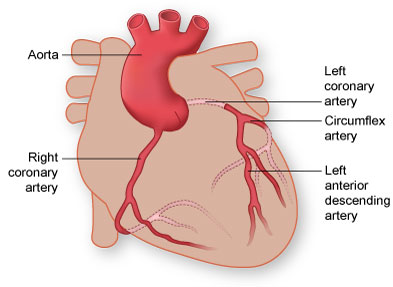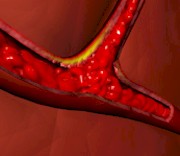Related terms: myocardium, coronary arteries, myocardial ischemia
Your heart is made of muscle, called the myocardium. The heart muscle, like every other organ or tissue in your body, needs oxygen-rich blood to survive. Blood is supplied to the heart muscle by the coronary arteries, which sit on the surface of the heart.
What is a myocardial bridge?
 A myocardial bridge is a band of heart muscle that lies on top of a coronary artery, instead of underneath it. With a myocardial bridge, part of a coronary artery dips into and underneath the heart muscle and then comes back out again.
A myocardial bridge is a band of heart muscle that lies on top of a coronary artery, instead of underneath it. With a myocardial bridge, part of a coronary artery dips into and underneath the heart muscle and then comes back out again.
What are the risks of a myocardial bridge?
For the most part, a myocardial bridge is harmless. Patients with a myocardial bridge have it from birth, and most never know they have the condition.
However, some patients can develop myocardial ischemia (lack of oxygen) because of a myocardial bridge. Myocardial ischemia means that the heart muscle is not getting enough oxygen-rich blood. When the heart "squeezes" (contracts) during the heartbeat, the bridge of heart muscle can "tighten down" on the artery, pinching it and decreasing the blood flow. Luckily, most of the blood flow through the heart happens during the "rest" phase of the heartbeat, not during the "squeezing" phase. Even so, the tightening of the bridge on the artery can decrease blood flow enough that myocardial ischemia develops, especially during exercise or when the heart is beating quickly.
What are the symptoms?
Up to one-third of patients with a myocardial bridge do not have any symptoms, even if their hearts are not getting enough blood supply. Symptoms are most likely caused by the myocardial ischemia and may include
- Chest pain
- Tightness in the chest or a feeling of pressure or heaviness on the chest
- Pain in the left arm or jaw
- Shortness of breath
- Fatigue (feeling very tired)
How is it diagnosed?
If you
experience symptoms, your doctor will use tests that show how blood is delivered to
parts of your heart:
- Cardiac catheterization with angiography to measure the blood flow and blood pressure in the heart chambers and see if the coronary arteries are blocked.
- An exercise stress test, which helps doctors see how the heart performs during exercise.
- A nuclear stress test, which can give information about the size of the heart's chambers, how well the heart is pumping blood, and whether the heart has any damaged or dead muscle.
How is it treated?
In most patients, a myocardial bridge is not treated if it is not causing any symptoms. In patients with symptoms, medicines such as beta-blockers and calcium channel blockers are usually the first line of treatment.
In rare cases, patients need surgery to relieve their symptoms. Surgery involves removing the bridge that is pressing on the coronary artery.
See also on this site:
Updated August 2016



